16 December 2022
2022 has seen many milestones in New Space, but supply-chain and regulatory problems still exist
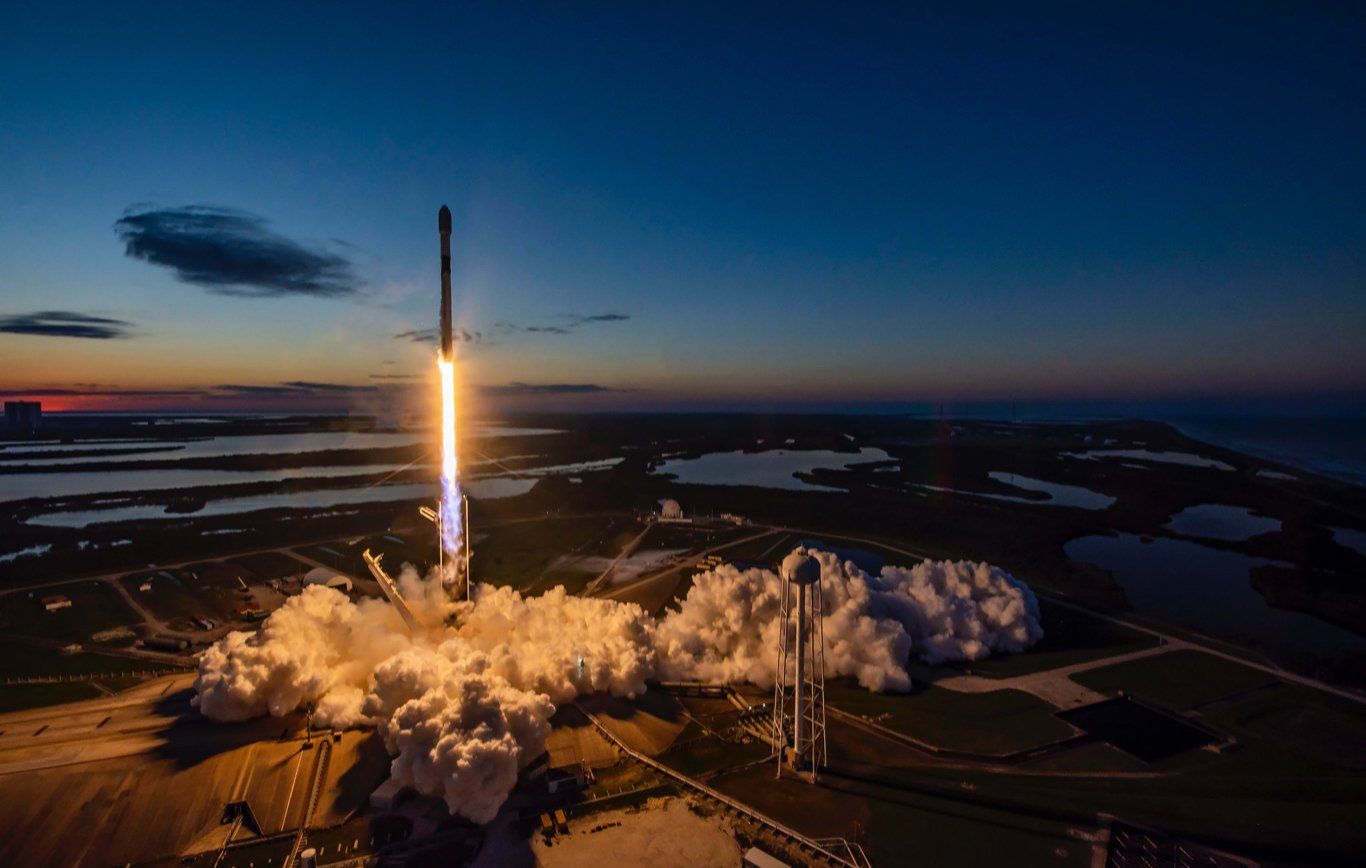
SpaceX have had a record-breaking year (Image: SpaceX)
This year has undoubtedly been remarkable in the development of New Space. Last week Artemis-1 concluded a successful mission, slashing down in the Pacific last Sunday. The 25 day mission carried tests on the launch vehicle, in readiness the send humans around the moon as part of Artemis-2, planned no earlier than 2025, and eventually sending astronauts back to the surface. “We’re one step closer to returning astronauts to the moon,” tweeted Vice President Kamala Harris.
Yet Artemis isn’t the only reason the celebrate the achievements of 2022. Last Sunday also saw the launch of the first commercial lander mission to the surface of the moon, with Japanese company, iSpace. The company will now follow the 5-month journey, ticking a series of 10 achievements along the way, as they look to complete the first full test of their lander technology. Also onboard was NASA’s Lunar Flashlight cubesat, which will be deployed into lunar orbit, and used in order to search for ice water in the crevasses of the moon.
Industry leaders such as SpaceX continue to break new records, new space nations are emerging and the private sector is taking a firm hand on the steering wheel of New Space. While it may seem that that we’re in for a good start for 2023, it is also evident that there are existing and emerging problems, which could seriously impact the growth of New Space.
Launch tech and innovation round-off a record year
China will also look back on a successful year, most notably this past month beginning operations on their Tiangong space station. "China plans to build the space station into a state-level space lab supporting long astronaut stays and large-scale scientific, technological, and application experiments," said Zhou Jianping, chief designer of China's manned space program. The station also represents China’s mission to garner support and build new international cooperation, and will be the first of its kind to open its doors to all UN member states.
This will include working alongside the ESA and will also host projects selected by the UNOOSA. China have also signed deals on cooperative projects with France, Germany, Italy, Russia and Pakistan. It seems that Tiangong may be China’s key to open up to the rest of the world, and is perhaps how they aim to take leadership in New Space.
This week China also demonstrated some of their new launch technology, carrying out the first launch a Jeilong-3 rocket from a mobile sea platform. Furthermore, private Chinese launch company, Landscape, carried out the world’s first methane-fuelled orbital launch, with their Zhuque-2 rocket, and whilst it is reported that the launch hasn’t been entirely successful, it is certainly indicative of the development the Chinese commercial sector.
India have also demonstrated the rise of their private space industry this week, with Indian company MTAR Technologies signing an agreement with Indian National Space Promotion and Authorization Centre (IN-SPACe) in order to design and a develop a new, two-stage LEO satellite launch vehicle. Also, Indian satellite maker GalaxEye has become the first company to receive seed funding ($3.5 mn) in the fastest time. The success of this funding can again be an indicator of the growth of the Indian private sector.
US company ThinkOrbital have announced that they will be designing a platform in order to manufacture products in-orbit. The platform would be built in space, and will can work “as a component of a larger commercial station or docked with a space vehicle like SpaceX’s Starship” (spacenews.com, 2022). Manufacture in orbit, utilising aspects such as micro-gravity, is already lined-up for the manufacture of products such as microchips and pharmaceuticals. The company is also looking into using the platform for gathering and recycling space debris into i.e. fuel. Orbital debris management and in-situ manufacture are both pressing topics at the moment, and using the former to service the latter could be a very effective breakthrough.
Looking also in building infrastructure in Earth orbit is US company, Sierra Space, who have carried out an Ultimate Burst Pressure (UBP) test on an inflatable space habitat, designed to be used as part of the Orbital Reef commercial space station. Lockheed Martin have also been carrying out similar tests on their inflatable habitats, designed to accommodate humans in LEO, on the moon and beyond. The feasibility of this technology will be crucial in allowing humans to spend extended periods of time in space.
Us company, Quantum Space, has received additional funding in order to advance the development of their satellite constellation planned for cislunar orbit, as well as developing their own ‘Ranger’ vehicle, which transport the initial satellites into their planned slot. The constellation is designed to provide communication, navigation situational awareness.
Technology is arriving, and at quite a pace. 2023 could witness the continued development of the launch industry, the growth of an orbital infrastructure, and laying further groundwork for long-term space habitation.
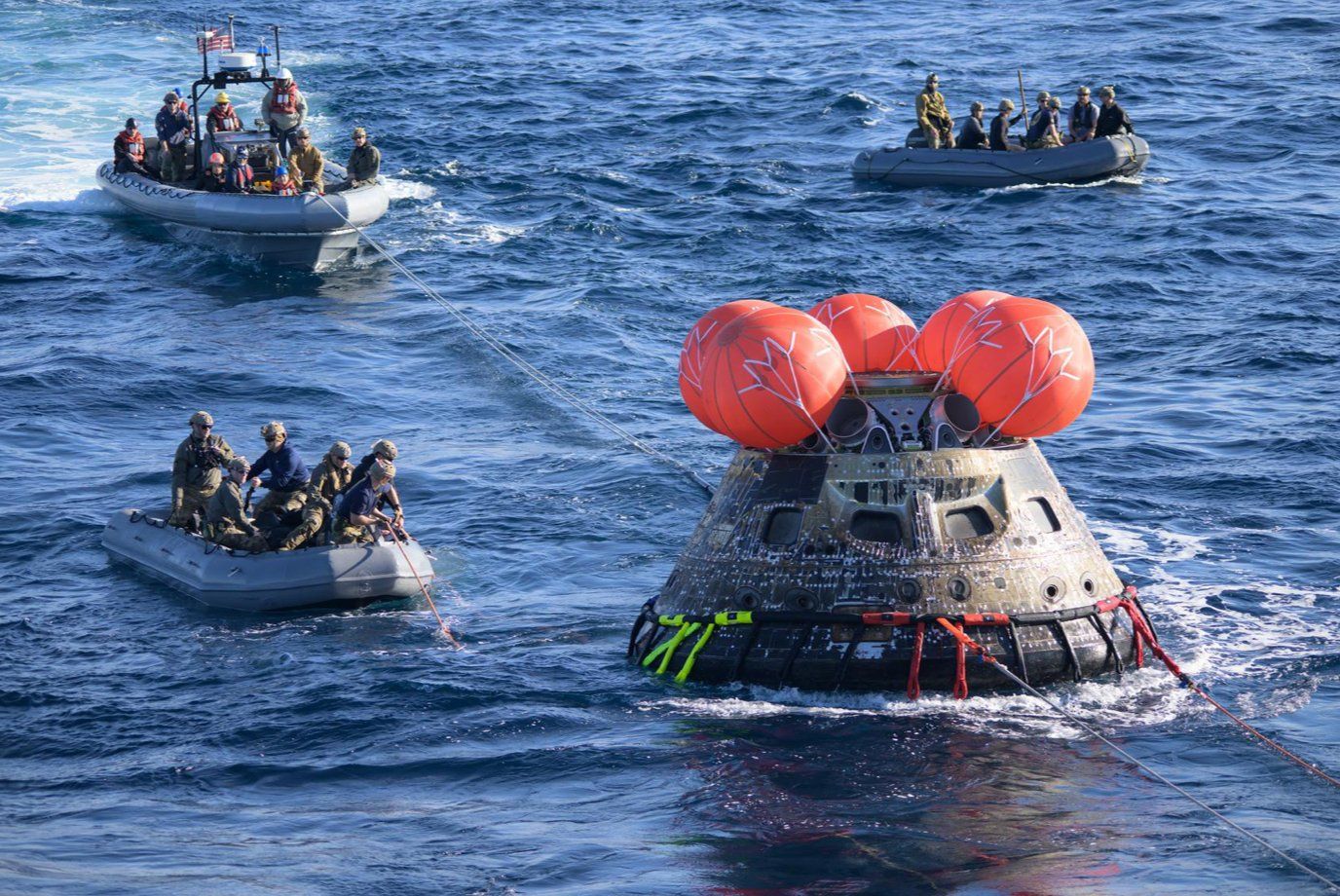
Orion returns to Earth after successful mission (Image: NASA)
Industry bottlenecks and geopolitics affecting the industry
Yet despite these positive signs, there are still issues that could stand in the way of a peaceful and successful New Space economy. One area that we regularly discuss is that of geopolitics seeping into space. The US and China continue to remain firm adversaries in this area, and this week China responded quickly to comments made by NASA chief, Bill Nelson, about the prospect of being in a new space race with China.
Nelson, when recently asked if the US will beat China to the moon, said “I think we will” (nikkei.com,2022). Furthermore, he claimed that “"There are very, very few nations that do not want to be partners with us (the US). China is one.” Chinese media took little time to retaliate, and accused the US of creating the illusion of a Chinese threat in order to pass legislation, “Nelson's renewed hype of the Chinese aviation threat theory is actually a common NASA trope, spinning an external excuse to spur the US Congress to pass more related budgets” (globaltimes.cn, 2022).
The Ukraine conflict also continues to impact the state of relations in space. Since the invasion, Russia has chosen to work more closely with China on their ILRS (lunar station) plans, and even prior to Ukraine, had began to distance itself from the Lunar Gateway project. Whilst under the command of former head, Dmitry Rogozin. The former Roscosmos chief claimed that the project was too US-centric. It’s now being reported that the UAE may be stepping-in as a new partner on Gateway, providing an airlock, and have apparently been working with NASA on the project for over a year already, according to ARS Technica (arstechnica.com, 2022). In 2023 we may see this trend continue, with geopolitical relations dictating the formation of new partnerships in space.
Another issue troubling the industry is the pace of licensing and regulation. For example, Virgin Orbit have recently had their maiden UK launch pushed back, partially as a result of regulatory issues. The Biden Administration is looking to streamline the process of gaining approval for private launches, and the UK has revealed a number of research projects they will be funding, one of which will be granted to UKLSL who are looking into the development of tools to streamline applications for spaceflight licences.
Another emerging problem is the lack of diversity in the launch market, with the US and Europe largely reliant on SpaceX. However, the Ukraine crisis may have proven that over-reliance on one service provider, can be far too risky. Casey Dreier, chief policy adviser for the Planetary Society, in an online forum hosted by the Center for the Study of the Presidency & Congress, said “Do you want to have just one provider of commercial satellite communications? Do you want to have just one provider of launch? Of course you don’t. And we’re seeing this chokepoint being revealed” (spacenews.com, 2022). Whilst there are a large number of companies developing space launch alternatives, many are yet to successfully get off the ground, such as Blue Origin’s New Glenn.
Would initiatives, such as easier licensing, help launches get off the ground? Furthermore, with increasing demand for diversity in the launch market, including responsive launch capabilities, will we see additional government funding rolled out, in order to get these rockets on the market quicker?

Breakthrough in nuclear fusion affect on New Space (Image: Adobe)
The urgency for renewed regulations and relations
Streamlined regulations in regards to licensing would certainly help simplify the process for space sector companies. However, there is a much bigger picture to look at, and that is regarding universally recognised rules governing activities in space, such as resource extraction. We’ve mentioned previously about the growth of ‘space blocs’, and this week it appears that these may be strengthening, with opposing blocs vying for the attention of newer space nations.
This week Nigeria and Rwanda were the first African nations to sign the US-led Artemis Accords. The US will be hoping for more to follow suit, but could be in competition with China, who already work with a number of African nations under their Belt and Road initiative. The US has also had more success, with their ASAT test ban, which has now passed a general assembly vote at the UN. Unsurprisingly, Russia and China were amongst the 9 nations that voted against the resolution.
Whilst these US initiatives seem to be an ongoing success, it seems unlikely that Russia and China will sign-up to them any time soon. However, former NASA official, Mike Gold, has perhaps found a new route in order to open-up discussions. In an article from Breaking Defense, it is claimed that “(Gold) said that in recent months he has participated in several seminars hosted by international non-governmental organizations, including The Hague International Space Resources Governance Working Group…Chinese government officials had positively contributed to discussions on rules and norms for space exploration” (breakingdefense.com, 2022). From the same article, it claimed that a Nicolas Maubert, space counselor at the French Embassy, said that “one possible venue for talks on the accords with the Chinese could be the annual November Paris Peace Forum”.
Would it be possible that neutral mediators, such as NGOs or Space Forums, perhaps located in countries that do have bilateral relations all parters, could be the place where adversaries can meet and have constructive discussions? Should this be an option, it needs to delivered quickly, as it appears that relations are quickly deteriorating, and at the same time the New Space economy is evolving rapidly. This week Iran and Russia will be discussing how they can deepen their space cooperation, and the US has expanded its Space Force into South Korea.
The biggest announcement of the week was that which came from California and the Lawrence Livermore National Laboratory. For the first time, they have managed to carry out a nuclear fusion test and generate more energy than what was used. This is the moment researchers and scientists have been working towards for decades, and promises the way forwards for clean and plentiful energy. Whilst it will still take years in order to commercialise and refine this technology, one has to wonder about the abundance of Helium-3 on the moon, seen as a potential fuel for fusion reactors. As history has shown us, where there has been a valuable source of energy, there has been conflict, and leaders of New Space must remember this. Now is the time to work together, and ensure that our future in space is a peaceful and shared one.
External Links
This Week
*News articles posted here are not property of ANASDA GmbH and belong to their respected owners. Postings here are external links only.
Our future in space
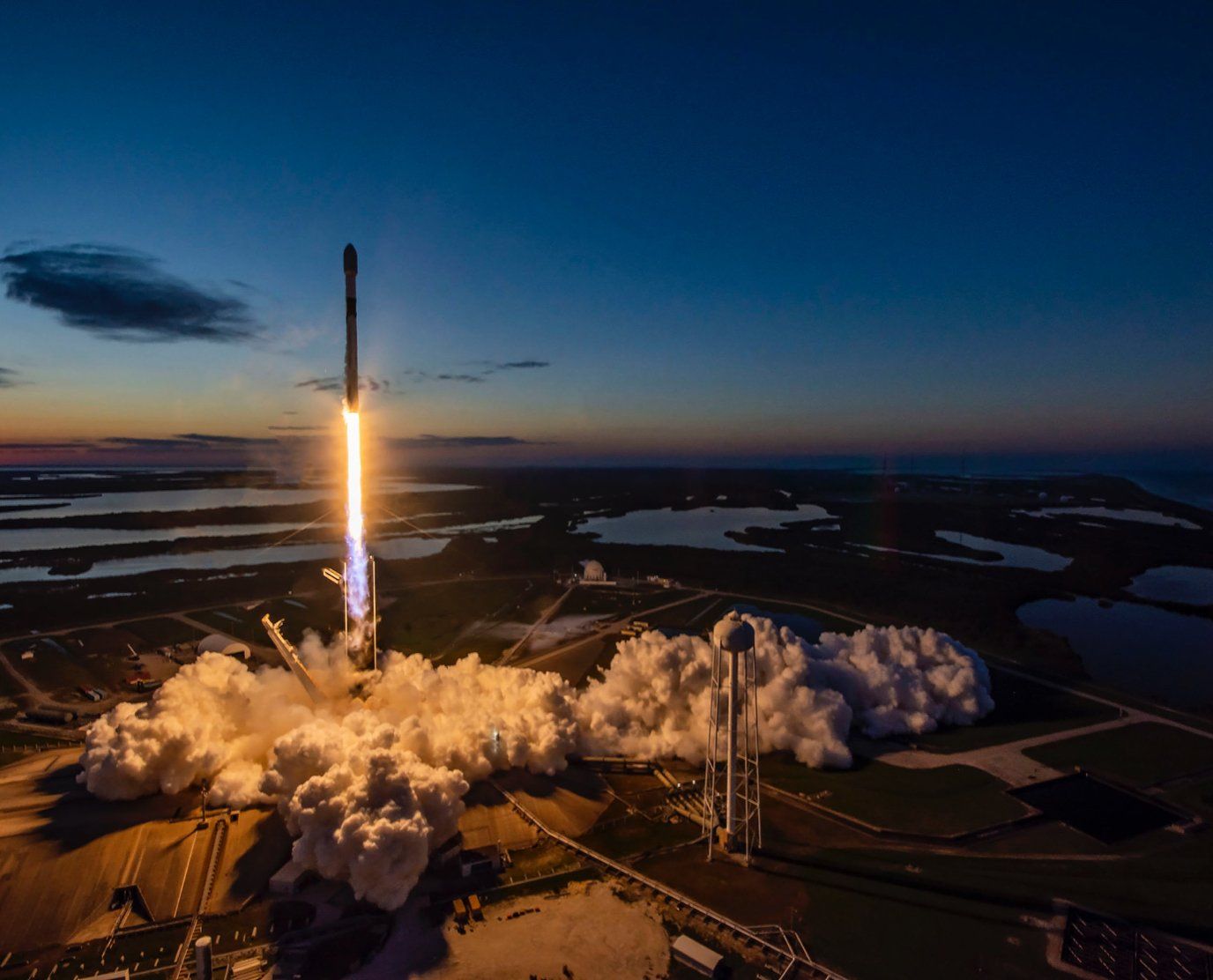
SpaceX have had a record-breaking year (Image: SpaceX)
16 December 2022
2022 has seen many milestones in New Space, but supply-chain and regulatory problems still exist
This year has undoubtedly been remarkable in the development of New Space. Last week Artemis-1 concluded a successful mission, slashing down in the Pacific last Sunday. The 25 day mission carried tests on the launch vehicle, in readiness the send humans around the moon as part of Artemis-2, planned no earlier than 2025, and eventually sending astronauts back to the surface. “We’re one step closer to returning astronauts to the moon,” tweeted Vice President Kamala Harris.
Yet Artemis isn’t the only reason the celebrate the achievements of 2022. Last Sunday also saw the launch of the first commercial lander mission to the surface of the moon, with Japanese company, iSpace. The company will now follow the 5-month journey, ticking a series of 10 achievements along the way, as they look to complete the first full test of their lander technology. Also onboard was NASA’s Lunar Flashlight cubesat, which will be deployed into lunar orbit, and used in order to search for ice water in the crevasses of the moon.
Industry leaders such as SpaceX continue to break new records, new space nations are emerging and the private sector is taking a firm hand on the steering wheel of New Space. While it may seem that that we’re in for a good start for 2023, it is also evident that there are existing and emerging problems, which could seriously impact the growth of New Space.
Launch tech and innovation round-off a record year
China will also look back on a successful year, most notably this past month beginning operations on their Tiangong space station. "China plans to build the space station into a state-level space lab supporting long astronaut stays and large-scale scientific, technological, and application experiments," said Zhou Jianping, chief designer of China's manned space program. The station also represents China’s mission to garner support and build new international cooperation, and will be the first of its kind to open its doors to all UN member states.
This will include working alongside the ESA and will also host projects selected by the UNOOSA. China have also signed deals on cooperative projects with France, Germany, Italy, Russia and Pakistan. It seems that Tiangong may be China’s key to open up to the rest of the world, and is perhaps how they aim to take leadership in New Space.
This week China also demonstrated some of their new launch technology, carrying out the first launch a Jeilong-3 rocket from a mobile sea platform. Furthermore, private Chinese launch company, Landscape, carried out the world’s first methane-fuelled orbital launch, with their Zhuque-2 rocket, and whilst it is reported that the launch hasn’t been entirely successful, it is certainly indicative of the development the Chinese commercial sector.
India have also demonstrated the rise of their private space industry this week, with Indian company MTAR Technologies signing an agreement with Indian National Space Promotion and Authorization Centre (IN-SPACe) in order to design and a develop a new, two-stage LEO satellite launch vehicle. Also, Indian satellite maker GalaxEye has become the first company to receive seed funding ($3.5 mn) in the fastest time. The success of this funding can again be an indicator of the growth of the Indian private sector.
US company ThinkOrbital have announced that they will be designing a platform in order to manufacture products in-orbit. The platform would be built in space, and will can work “as a component of a larger commercial station or docked with a space vehicle like SpaceX’s Starship” (spacenews.com, 2022). Manufacture in orbit, utilising aspects such as micro-gravity, is already lined-up for the manufacture of products such as microchips and pharmaceuticals. The company is also looking into using the platform for gathering and recycling space debris into i.e. fuel. Orbital debris management and in-situ manufacture are both pressing topics at the moment, and using the former to service the latter could be a very effective breakthrough.
Looking also in building infrastructure in Earth orbit is US company, Sierra Space, who have carried out an Ultimate Burst Pressure (UBP) test on an inflatable space habitat, designed to be used as part of the Orbital Reef commercial space station. Lockheed Martin have also been carrying out similar tests on their inflatable habitats, designed to accommodate humans in LEO, on the moon and beyond. The feasibility of this technology will be crucial in allowing humans to spend extended periods of time in space.
Us company, Quantum Space, has received additional funding in order to advance the development of their satellite constellation planned for cislunar orbit, as well as developing their own ‘Ranger’ vehicle, which transport the initial satellites into their planned slot. The constellation is designed to provide communication, navigation situational awareness.
Technology is arriving, and at quite a pace. 2023 could witness the continued development of the launch industry, the growth of an orbital infrastructure, and laying further groundwork for long-term space habitation.

Orion returns to Earth after successful mission (Image: NASA)
Industry bottlenecks and geopolitics affecting the industry
Yet despite these positive signs, there are still issues that could stand in the way of a peaceful and successful New Space economy. One area that we regularly discuss is that of geopolitics seeping into space. The US and China continue to remain firm adversaries in this area, and this week China responded quickly to comments made by NASA chief, Bill Nelson, about the prospect of being in a new space race with China.
Nelson, when recently asked if the US will beat China to the moon, said “I think we will” (nikkei.com,2022). Furthermore, he claimed that “"There are very, very few nations that do not want to be partners with us (the US). China is one.” Chinese media took little time to retaliate, and accused the US of creating the illusion of a Chinese threat in order to pass legislation, “Nelson's renewed hype of the Chinese aviation threat theory is actually a common NASA trope, spinning an external excuse to spur the US Congress to pass more related budgets” (globaltimes.cn, 2022).
The Ukraine conflict also continues to impact the state of relations in space. Since the invasion, Russia has chosen to work more closely with China on their ILRS (lunar station) plans, and even prior to Ukraine, had began to distance itself from the Lunar Gateway project. Whilst under the command of former head, Dmitry Rogozin. The former Roscosmos chief claimed that the project was too US-centric. It’s now being reported that the UAE may be stepping-in as a new partner on Gateway, providing an airlock, and have apparently been working with NASA on the project for over a year already, according to ARS Technica (arstechnica.com, 2022). In 2023 we may see this trend continue, with geopolitical relations dictating the formation of new partnerships in space.
Another issue troubling the industry is the pace of licensing and regulation. For example, Virgin Orbit have recently had their maiden UK launch pushed back, partially as a result of regulatory issues. The Biden Administration is looking to streamline the process of gaining approval for private launches, and the UK has revealed a number of research projects they will be funding, one of which will be granted to UKLSL who are looking into the development of tools to streamline applications for spaceflight licences.
Another emerging problem is the lack of diversity in the launch market, with the US and Europe largely reliant on SpaceX. However, the Ukraine crisis may have proven that over-reliance on one service provider, can be far too risky. Casey Dreier, chief policy adviser for the Planetary Society, in an online forum hosted by the Center for the Study of the Presidency & Congress, said “Do you want to have just one provider of commercial satellite communications? Do you want to have just one provider of launch? Of course you don’t. And we’re seeing this chokepoint being revealed” (spacenews.com, 2022). Whilst there are a large number of companies developing space launch alternatives, many are yet to successfully get off the ground, such as Blue Origin’s New Glenn.
Would initiatives, such as easier licensing, help launches get off the ground? Furthermore, with increasing demand for diversity in the launch market, including responsive launch capabilities, will we see additional government funding rolled out, in order to get these rockets on the market quicker?

Breakthrough in nuclear fusion affect on New Space (Image: Adobe)
The urgency for renewed regulations and relations
Streamlined regulations in regards to licensing would certainly help simplify the process for space sector companies. However, there is a much bigger picture to look at, and that is regarding universally recognised rules governing activities in space, such as resource extraction. We’ve mentioned previously about the growth of ‘space blocs’, and this week it appears that these may be strengthening, with opposing blocs vying for the attention of newer space nations.
This week Nigeria and Rwanda were the first African nations to sign the US-led Artemis Accords. The US will be hoping for more to follow suit, but could be in competition with China, who already work with a number of African nations under their Belt and Road initiative. The US has also had more success, with their ASAT test ban, which has now passed a general assembly vote at the UN. Unsurprisingly, Russia and China were amongst the 9 nations that voted against the resolution.
Whilst these US initiatives seem to be an ongoing success, it seems unlikely that Russia and China will sign-up to them any time soon. However, former NASA official, Mike Gold, has perhaps found a new route in order to open-up discussions. In an article from Breaking Defense, it is claimed that “(Gold) said that in recent months he has participated in several seminars hosted by international non-governmental organizations, including The Hague International Space Resources Governance Working Group…Chinese government officials had positively contributed to discussions on rules and norms for space exploration” (breakingdefense.com, 2022). From the same article, it claimed that a Nicolas Maubert, space counselor at the French Embassy, said that “one possible venue for talks on the accords with the Chinese could be the annual November Paris Peace Forum”.
Would it be possible that neutral mediators, such as NGOs or Space Forums, perhaps located in countries that do have bilateral relations all parters, could be the place where adversaries can meet and have constructive discussions? Should this be an option, it needs to delivered quickly, as it appears that relations are quickly deteriorating, and at the same time the New Space economy is evolving rapidly. This week Iran and Russia will be discussing how they can deepen their space cooperation, and the US has expanded its Space Force into South Korea.
The biggest announcement of the week was that which came from California and the Lawrence Livermore National Laboratory. For the first time, they have managed to carry out a nuclear fusion test and generate more energy than what was used. This is the moment researchers and scientists have been working towards for decades, and promises the way forwards for clean and plentiful energy. Whilst it will still take years in order to commercialise and refine this technology, one has to wonder about the abundance of Helium-3 on the moon, seen as a potential fuel for fusion reactors. Furthermore, the use of nuclear fusion in propulsion systems is already being researched, by companies such as UK-based Pulsar Fusion. As history has shown us, where there has been a valuable source of energy, there has been conflict, and leaders of New Space must remember this. Now is the time to work together, and ensure that our future in space is a peaceful and shared one.
Share this article
External Links
This Week
*News articles posted here are not property of ANASDA GmbH and belong to their respected owners. Postings here are external links only.
16 Dec 2022
2022 has seen many milestones in New Space, but supply-chain and regulatory problems still exist
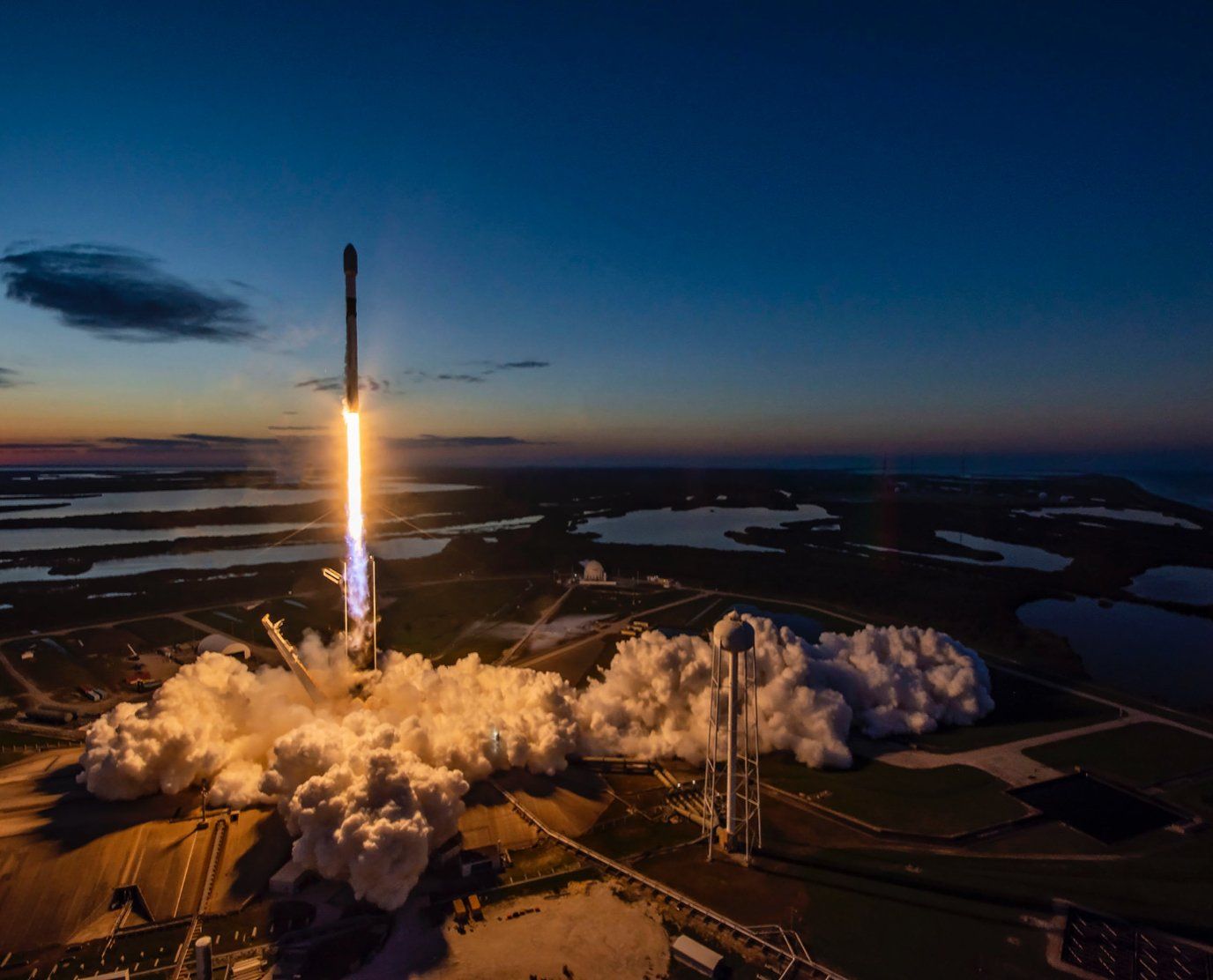
SpaceX have had a record-breaking year (Image: SpaceX)
This year has undoubtedly been remarkable in the development of New Space. Last week Artemis-1 concluded a successful mission, slashing down in the Pacific last Sunday. The 25 day mission carried tests on the launch vehicle, in readiness the send humans around the moon as part of Artemis-2, planned no earlier than 2025, and eventually sending astronauts back to the surface. “We’re one step closer to returning astronauts to the moon,” tweeted Vice President Kamala Harris.
Yet Artemis isn’t the only reason the celebrate the achievements of 2022. Last Sunday also saw the launch of the first commercial lander mission to the surface of the moon, with Japanese company, iSpace. The company will now follow the 5-month journey, ticking a series of 10 achievements along the way, as they look to complete the first full test of their lander technology. Also onboard was NASA’s Lunar Flashlight cubesat, which will be deployed into lunar orbit, and used in order to search for ice water in the crevasses of the moon.
Industry leaders such as SpaceX continue to break new records, new space nations are emerging and the private sector is taking a firm hand on the steering wheel of New Space. While it may seem that that we’re in for a good start for 2023, it is also evident that there are existing and emerging problems, which could seriously impact the growth of New Space.
Launch tech and innovation round-off a record year
China will also look back on a successful year, most notably this past month beginning operations on their Tiangong space station. "China plans to build the space station into a state-level space lab supporting long astronaut stays and large-scale scientific, technological, and application experiments," said Zhou Jianping, chief designer of China's manned space program. The station also represents China’s mission to garner support and build new international cooperation, and will be the first of its kind to open its doors to all UN member states.
This will include working alongside the ESA and will also host projects selected by the UNOOSA. China have also signed deals on cooperative projects with France, Germany, Italy, Russia and Pakistan. It seems that Tiangong may be China’s key to open up to the rest of the world, and is perhaps how they aim to take leadership in New Space.
This week China also demonstrated some of their new launch technology, carrying out the first launch a Jeilong-3 rocket from a mobile sea platform. Furthermore, private Chinese launch company, Landscape, carried out the world’s first methane-fuelled orbital launch, with their Zhuque-2 rocket, and whilst it is reported that the launch hasn’t been entirely successful, it is certainly indicative of the development the Chinese commercial sector.
India have also demonstrated the rise of their private space industry this week, with Indian company MTAR Technologies signing an agreement with Indian National Space Promotion and Authorization Centre (IN-SPACe) in order to design and a develop a new, two-stage LEO satellite launch vehicle. Also, Indian satellite maker GalaxEye has become the first company to receive seed funding ($3.5 mn) in the fastest time. The success of this funding can again be an indicator of the growth of the Indian private sector.
US company ThinkOrbital have announced that they will be designing a platform in order to manufacture products in-orbit. The platform would be built in space, and will can work “as a component of a larger commercial station or docked with a space vehicle like SpaceX’s Starship” (spacenews.com, 2022). Manufacture in orbit, utilising aspects such as micro-gravity, is already lined-up for the manufacture of products such as microchips and pharmaceuticals. The company is also looking into using the platform for gathering and recycling space debris into i.e. fuel. Orbital debris management and in-situ manufacture are both pressing topics at the moment, and using the former to service the latter could be a very effective breakthrough.
Looking also in building infrastructure in Earth orbit is US company, Sierra Space, who have carried out an Ultimate Burst Pressure (UBP) test on an inflatable space habitat, designed to be used as part of the Orbital Reef commercial space station. Lockheed Martin have also been carrying out similar tests on their inflatable habitats, designed to accommodate humans in LEO, on the moon and beyond. The feasibility of this technology will be crucial in allowing humans to spend extended periods of time in space.
Us company, Quantum Space, has received additional funding in order to advance the development of their satellite constellation planned for cislunar orbit, as well as developing their own ‘Ranger’ vehicle, which transport the initial satellites into their planned slot. The constellation is designed to provide communication, navigation situational awareness.
Technology is arriving, and at quite a pace. 2023 could witness the continued development of the launch industry, the growth of an orbital infrastructure, and laying further groundwork for long-term space habitation.
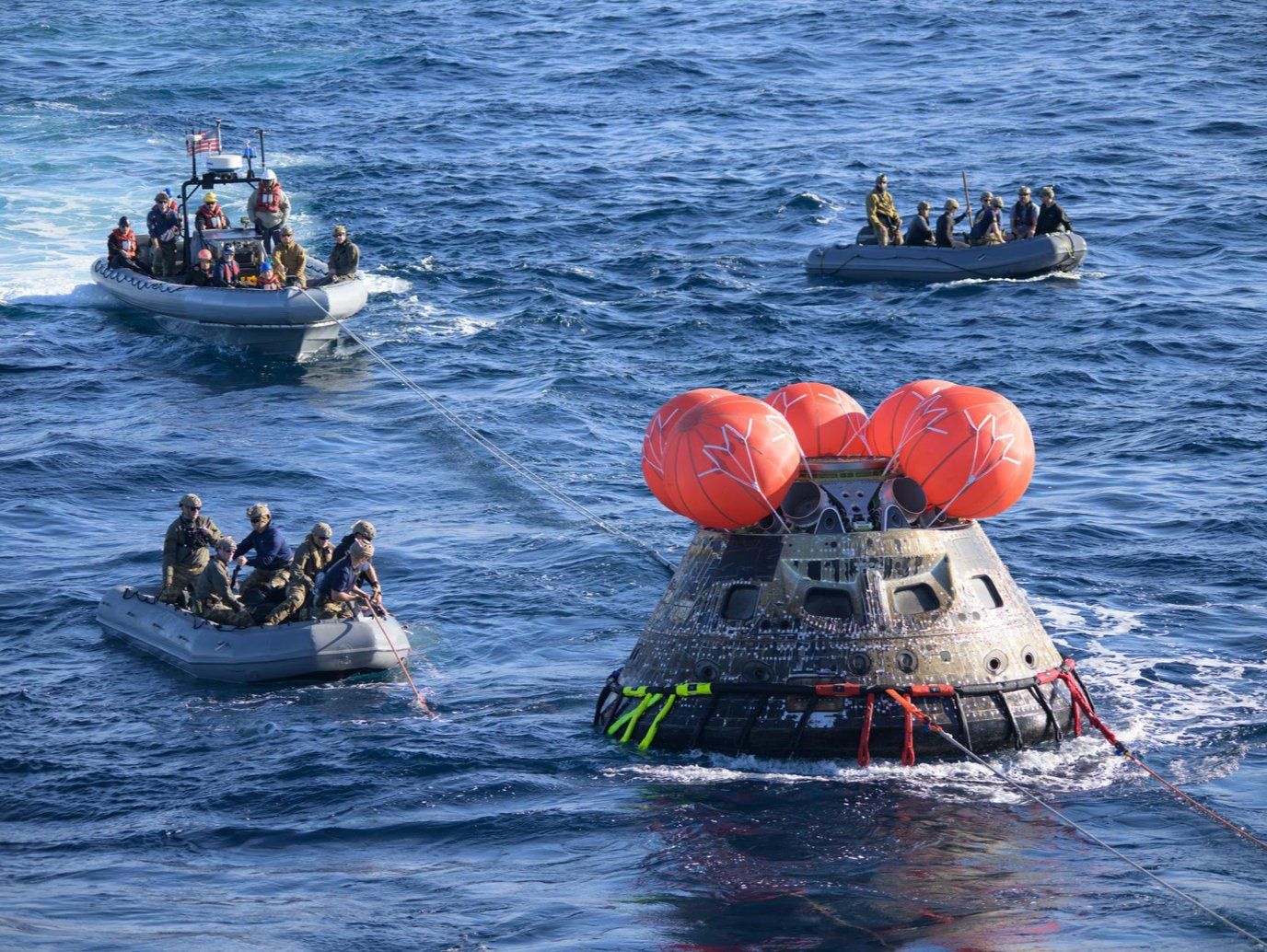
Orion returns to Earth after successful mission (Image: NASA)
Industry bottlenecks and geopolitics affecting the industry
Yet despite these positive signs, there are still issues that could stand in the way of a peaceful and successful New Space economy. One area that we regularly discuss is that of geopolitics seeping into space. The US and China continue to remain firm adversaries in this area, and this week China responded quickly to comments made by NASA chief, Bill Nelson, about the prospect of being in a new space race with the China.
Nelson, when recently asked if the US will beat China to the moon, said “I think we will” (nikkei.com,2022). Furthermore, he claimed that “"There are very, very few nations that do not want to be partners with us (the US). China is one.” Chinese media took little time to retaliate, and accused the US of creating the illusion of a Chinese threat in order to pass legislation, “Nelson's renewed hype of the Chinese aviation threat theory is actually a common NASA trope, spinning an external excuse to spur the US Congress to pass more related budgets” (globaltimes.cn, 2022).
The Ukraine conflict also continues to impact the state of relations in space. Since the invasion, Russia has chosen to work more closely with China on their ILRS (lunar station) plans, and even prior to Ukraine, had began to distance itself from the Lunar Gateway project. Whilst under the command of former head, Dmitry Rogozin. The former Roscosmos chief claimed that the project was too US-centric. It’s now being reported that the UAE may be stepping-in as a new partner on Gateway, providing an airlock, and have apparently been working with NASA on the project for over a year already, according to ARS Technica (arstechnica.com, 2022). In 2023 we may see this trend continue, with geopolitical relations dictating the formation of new partnerships in space.
Another issue troubling the industry is the pace of licensing and regulation. For example, Virgin Orbit have recently had their maiden UK launch pushed back, partially as a result of regulatory issues. The Biden Administration is looking to streamline the process of gaining approval for private launches, and the UK has revealed a number of research projects they will be funding, one of which will be granted to UKLSL who are looking into the development of tools to streamline applications for spaceflight licences.
Another emerging problem is the lack of diversity in the launch market, with the US and Europe largely reliant on SpaceX. However, the Ukraine crisis may have proven that over-reliance on one service provider, can be far too risky. Casey Dreier, chief policy adviser for the Planetary Society, in an online forum hosted by the Center for the Study of the Presidency & Congress, said “Do you want to have just one provider of commercial satellite communications? Do you want to have just one provider of launch? Of course you don’t. And we’re seeing this chokepoint being revealed” (spacenews.com, 2022). Whilst there are a large number of companies developing space launch alternatives, many are yet to successfully get off the ground, such as Blue Origin’s New Glenn.
Would initiatives, such as easier licensing, help launches get off the ground? Furthermore, with increasing demand for diversity in the launch market, including responsive launch capabilities, will we see additional government funding rolled out, in order to get these rockets on the market quicker?

Breakthrough in nuclear fusion could have big affect on New Space (Image: Adobe)
The urgency for renewed regulations and relations
Streamlined regulations in regards to licensing would certainly help simplify the process for space sector companies. However, there is a much bigger picture to look at, and that is regarding universally recognised rules governing activities in space, such as resource extraction. We’ve mentioned previously about the growth of ‘space blocs’, and this week it appears that these may be strengthening, with opposing blocs vying for the attention of newer space nations.
This week Nigeria and Rwanda were the first African nations to sign the US-led Artemis Accords. The US will be hoping for more to follow suit, but could be in competition with China, who already work with a number of African nations under their Belt and Road initiative. The US has also had more success, with their ASAT test ban, which has now passed a general assembly vote at the UN. Unsurprisingly, Russia and China were amongst the 9 nations that voted against the resolution.
Whilst these US initiatives seem to be an ongoing success, it seems unlikely that Russia and China will sign-up to them any time soon. However, former NASA official, Mike Gold, has perhaps found a new route in order to open-up discussions. In an article from Breaking Defense, it is claimed that “(Gold) said that in recent months he has participated in several seminars hosted by international non-governmental organizations, including The Hague International Space Resources Governance Working Group…Chinese government officials had positively contributed to discussions on rules and norms for space exploration” (breakingdefense.com, 2022). From the same article, it claimed that a Nicolas Maubert, space counselor at the French Embassy, said that “one possible venue for talks on the accords with the Chinese could be the annual November Paris Peace Forum”.
Would it be possible that neutral mediators, such as NGOs or Space Forums, perhaps located in countries that do have bilateral relations all parters, could be the place where adversaries can meet and have constructive discussions? Should this be an option, it needs to delivered quickly, as it appears that relations are quickly deteriorating, and at the same time the New Space economy is evolving rapidly. This week Iran and Russia will be discussing how they can deepen their space cooperation, and the US has expanded its Space Force into South Korea.
The biggest announcement of the week was that which came from California and the Lawrence Livermore National Laboratory. For the first time, they have managed to carry out a nuclear fusion test and generate more energy than what was used. This is the moment researchers and scientists have been working towards for decades, and promises the way forwards for clean and plentiful energy. Whilst it will still take years in order to commercialise and refine this technology, one has to wonder about the abundance of Helium-3 on the moon, seen as a potential fuel for fusion reactors. As history has shown us, where there has been a valuable source of energy, there has been conflict, and leaders of New Space must remember this. Now is the time to work together, and ensure that our future in space is a peaceful and shared one.
Share this article
External Links
This Week
*News articles posted here are not property of ANASDA GmbH and belong to their respected owners. Postings here are external links only.





























